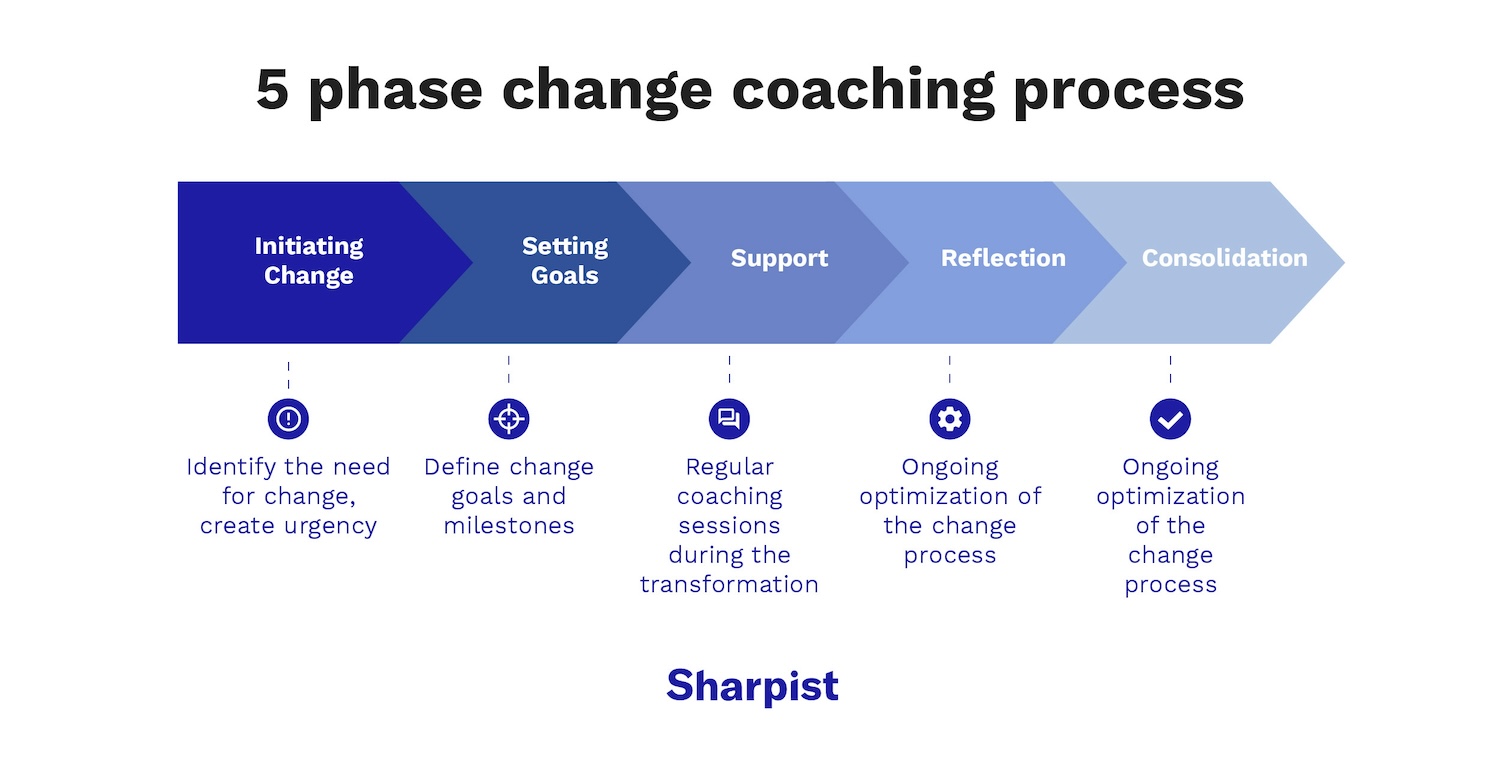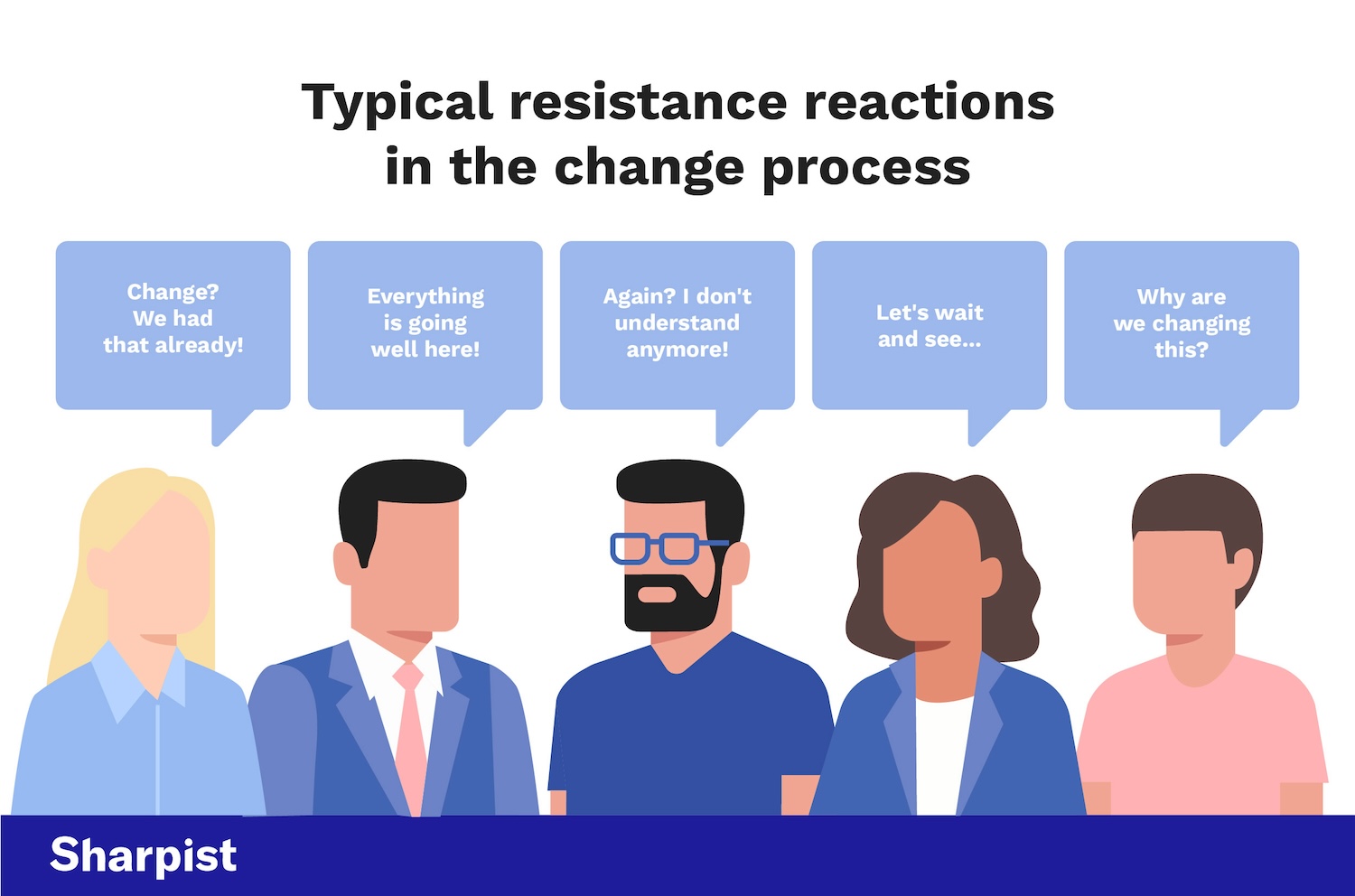The Topic In A Nutshell
What Is Change Management Coaching?
Change management coaching systematically guides managers and employees through organizational change. As a specialized form of business coaching, it focuses specifically on transformation contexts and the challenges associated with them. Unlike traditional consulting, a change coach does not provide ready-made solutions, but focuses on the people who implement the change: it develops change skills, provides emotional support, and assists with practical implementation.
Essentially, it is about actively shaping change processes: tolerating uncertainty, dealing with resistance constructively, communicating change authentically, and guiding teams through turbulent phases. Change management coaching is aimed at various target groups:
Coaching complements strategic change management on a personal level. Digital coaching platforms such as Sharpist combine personal support with scalability. This allows you to reach hundreds of managers at the same time, with consistent quality standards and transparent success tracking.

Why Is Change Management Coaching Crucial For Success?
Change triggers psychological reactions: fear of loss, loss of control, uncertainty. Without professional support, performance declines, resistance grows, and transformations fail. Coaching addresses this emotional dimension directly and creates a safe space for reflection and coping strategies.
The multiplier effect is particularly valuable. Well-coached executives communicate change more authentically because they themselves have gained clarity. They radiate confidence, create meaning, and act as an anchor in uncertain times. The effect is amplified throughout the entire organization.
Sustainability distinguishes coaching from training. While seminars impart knowledge in the short term, individual coaching anchors new behaviors in the long term. This is because training primarily imparts know-how, whereas coaching develops the ability to apply this knowledge in complex change situations and adapt it to specific contexts. The measurable impact: Studies show a 30 to 40% higher success rate in change projects with accompanying coaching. Organizations also report:
At Miro, for example, Sharpist's change management coaching led to 100% retention of key personnel during a restructuring.

How Does Change Management Coaching Work In Practice?
Change management coaching follows a structured process that flexibly adapts to the phases of change. The coaching cycle begins with an analysis of the change situation and individual challenges. This involves defining coaching goals that fit both the transformation strategy and personal development.
The implementation phase comprises regular sessions in which specific change situations are reflected upon, options for action are developed, and new behaviors are tested. Between sessions, coachees work on practical exercises. This integration of coaching conversations and practical transfer makes the difference between knowledge transfer and behavioral change.
The anchoring phase consolidates new skills and integrates them into everyday life. Follow-up sessions ensure sustainability. A good coaching process ends deliberately so that what has been learned can be continued independently in one's own change management.

Typical Coaching Formats For Change Management
In individual coaching, change coaches develop change leadership skills in confidential one-on-one sessions. Leaders work on their own ambivalences, prepare for difficult conversations, and strengthen their resilience. In team coaching, team dynamics are addressed, conflicts are dealt with constructively, and a collective focus on new goals is created. This is particularly valuable when breaking down silos.
In group coaching, change agents from different areas come together for peer learning. The exchange of experiences creates valuable networking opportunities. In the event of acute challenges, crisis coaching offers intensive support. This includes, for example: escalating resistance, disappointing project results, overwhelmed managers.
Digital formats such as Sharpist enable continuous support without travel expenses through video sessions, chat support, and flexible scheduling. This is ideal for large, distributed organizations. An overview of the coaching formats:
Proven Methods In Change Coaching
The approach used in change coaching combines various proven methods that encourage reflection and enable behavioral change.
Systemic questioning techniques break down entrenched perspectives: "If the change were successful, how would you notice it specifically?" or "What hidden advantages could the status quo have for your team?". Questions like these break down entrenched patterns of thinking and open up new options for action. Visualization methods such as stakeholder maps make complex change dynamics tangible and show at a glance who supports the change and where persuasion is needed.
Role-playing games prepare you for difficult conversations. Change communication with skeptical employees can be practiced in the protected environment of coaching—without any real consequences. Reflection exercises promote self-awareness: How do I react to change myself? If you understand your own resistance, you can better deal with that of others. Proven change management models such as Kotter's 8-step process, the ADKAR model, or the Kübler-Ross change curve offer additional guidance and can be adapted to individual needs.

Resistance Management In Change Coaching
Change management coaching begins with a change of perspective: resistance is not a disruptive factor, but valuable information about unmet needs, unclear communication, or real problems in the change strategy.
An experienced change coach helps managers to look beyond the resistance: What is the real concern? What need is not being met? This analytical approach replaces reactive enforcement with constructive understanding. The development of emotional intelligence is central to this—managers learn to deal with fears, frustration, and anger empathetically without allowing themselves to be overwhelmed by them.

Constructive dialogue transforms resistance into productive conversations. Instead of blocking objections, good change communication invites discussion: "I hear your concerns. Help me understand exactly what you fear. "Differentiated stakeholder strategies recognize that active opponents require different approaches than passive skeptics. The protected setting of coaching also allows for honest reflection on one's own ambivalence, an issue often overlooked by managers.
Who Is Change Management Coaching Suitable For?
Who is change management coaching suitable for? Change management coaching is suitable for managers at all levels – with specific areas of focus in each case:
Change managers and project managers develop key future skills: Dealing with uncertainty and actively shaping change. Change management coaching complements traditional continuing education with practical reflection on real transformation challenges. Change experience becomes a career accelerator, as transformation competence is one of the most sought-after leadership skills.
Young executives and high potentials develop key future skills: Dealing with uncertainty and actively shaping change. Change experience becomes a career accelerator, as transformation competence is one of the most sought-after leadership skills. Entire teams benefit from structured team coaching during mergers, reorganizations, or new ways of working. Change management coaching is particularly valuable in complex transformation phases: mergers, digital transformations, or cultural change. Here, the investment pays off in the form of measurably higher success rates and shorter project durations.

The Advantages Of Change Management Coaching At A Glance
Investing in change management coaching pays off in measurable ways:
Tip: ROI calculator
Calculate the potential savings for your change project: Go to ROI calculator

Successfully Implementing Change Management Coaching In Your Company
Coaching as a change tool itself needs to be implemented effectively. The most common mistakes in these change processes are as follows:
Strategic planning first clarifies: Which target groups should receive coaching in which change phases and with what intensity? Requirements vary depending on the depth of transformation – post-merger integration poses different challenges than digital transformation. Prioritizing according to strategic relevance ensures efficient use of resources.
The change story positions business coaching as an integral part of the transformation: "We take this change seriously and are investing in your development." This message conveys appreciation and signals that the organization is professionally supporting the change.
Internal communication and marketing determine acceptance. Sharing success stories, gathering testimonials, and positioning coaching as a privilege breaks down stigmas. Particularly effective: when top management talks openly about their own coaching, it creates a culture of openness to learning. Clear processes for nomination, registration, and starting coaching create commitment. Simple procedures, defined responsibilities, and quick access are crucial for high activation rates.
Challenges And Success Factors In Practice
The following success factors play an important role in the implementation of change management coaching:
Change Fatigue: The Underestimated Challenge In Change Management
In many organizations, one transformation follows another: digitalization, reorganization, post-merger integration. Employees and managers develop change fatigue: emotional and cognitive exhaustion due to constant change. The consequences:
Change fatigue acts like invisible resistance that cannot be overcome through better communication. Managers are particularly vulnerable to this. They have to communicate changes that they themselves have not fully processed, while at the same time radiating confidence. This double burden leads to burnout and untrustworthy communication.

Recognizing Symptoms Of Change Fatigue
Early warning signs include cynicism and resignation: employees respond to new initiatives with eye rolls instead of curiosity. Increased error rates indicate cognitive overload: constant adaptation ties up mental capacity, leaving less energy for concentrated work.
Late indicators include rising sick leave and staff turnover. The loss of top performers should be particularly alarming, as the best employees are often the first to leave exhausting environments. Managers are often overlooked as affected parties: their suppressed exhaustion can lead to passive-aggressive behavior and declining leadership quality.

Coaching As A Buffer Against Change Fatigue
Professional change coaching helps managers and teams identify their own sources of energy, set boundaries, and develop individual resilience strategies.
Conveying meaning is the most effective remedy for exhaustion.: When people understand why change is important, they are more willing to invest energy in it. Coaching helps managers develop authentic answers to the "why" question and communicate them convincingly.
Realistic prioritization reduces excessive demands. Not everything can be changed at once. Coaching supports strategic change planning and the conscious incorporation of recovery phases between waves of change. These breathing spaces are not a weakness, but a necessary prerequisite for sustainable transformation.
Regular coaching sessions function as an early warning system: they identify signs of exhaustion early on, before they become critical. Aggregated feedback reveals organization-wide patterns of overload that HR teams can address in a targeted manner. Proven exercises such as the "energy audit" technique identify which change activities give strength and which exhaust. The "stability anchor" method creates conscious havens of calm in the whirlwind of change.
Now Is The Time To Approach Change Management Coaching As An Investment In Sustainable Transformation
Professional coaching gives your managers the stamina and mental strength they need for long transformation processes. The investment pays off: in faster implementation, less resistance, and an organization that sees change as normal.
Sharpist makes this investment scalable and measurable: Over 1,500 experienced business coaches, flexible digital formats, and data-driven management systematically develop change competencies throughout your organization.
What sets Sharpist apart:
Change competence is the future viability of your organization. Invest in the people who will drive your transformation.
FAQ
What Is The ROI Of Change Management Coaching?
The return on investment is measurable: 30 % shorter implementation times, 15 to 25 % lower staff turnover, higher productivity. Studies show an average ROI of 5 to 7x. Sharpist customers report 30 % faster implementation and 40 % higher executive satisfaction. Qualitative effects such as a stronger culture of change and more resilient managers contribute to future transformations.
How Does Change Management Coaching Differ From Traditional Consulting Or Training?
The optimal solution is to integrate all three approaches.
When Is The Right Time For Change Coaching?
Ideally, change coaching should be used as early as the planning phase. However, coaching is still worthwhile at later stages:
Should We Use Internal Or External Change Coaches?
Sharpist: External coach network combined with internal HR management – scalable and affordable.
What Skills Do Managers Develop Through Change Management Coaching?
Through change management coaching, managers develop the following skills:
How Long Does A Coaching Change Management Process Take?
Sustainable behavioral change takes time. Initial successes emerge after two to three months, with genuine transformation occurring after six to twelve months.
Which Change Management Coaching Exercises Can I Apply Immediately?
If you would like to start right away with targeted exercises, the following exercises are recommended:





.png)


.svg)



%20(1).png)


